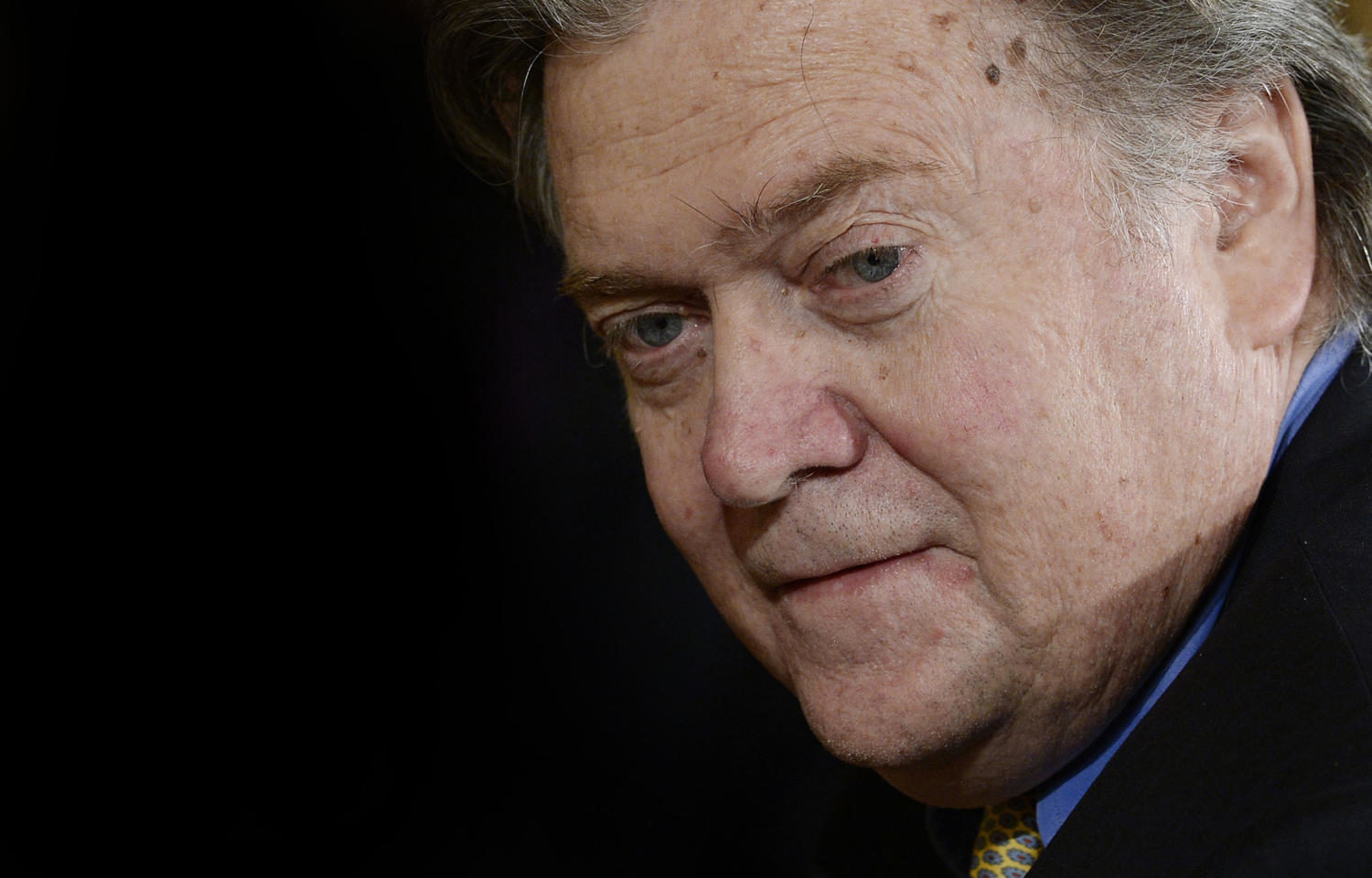Steve Bannon out as Trump’s chief strategist
Steve Bannon looks on in the East Room of the White House on Feb. 10, 2017 in Washington, D.C. (Olivier Douliery/Abaca Press/TNS)
August 18, 2017
Steve Bannon, President Donald Trump’s self-styled liaison to the far right, has departed the White House in the latest staff turmoil, the White House said in a statement.
“White House Chief of Staff John Kelly and Steve Bannon have mutually agreed today would be Steve’s last day,” the White House statement said. “We are grateful for his service and wish him the best.”
Long-simmering speculation that Bannon would be forced out intensified recently when retired Marine Gen. John F. Kelly became White House chief of staff, charged with restoring discipline and order. Among other things, Bannon is suspected of stoking right-wing opposition to national security adviser H.R. McMaster.
Advertisement
But by Friday, he had apparently also lost the support of the president for his combativeness, after months of alienating many others within the administration.
Trump declined to guarantee Bannon’s job earlier this week in a news conference, when asked about his strategist’s future. And his remarks suggested a resentment that Bannon came in for any credit for Trump’s ascension.
“Well, we’ll see,” Trump said. “I like Mr. Bannon. He’s a friend of mine. But Mr. Bannon came on very late, you know that. I went through 17 senators, governors, and I won all the primaries. Mr. Bannon came on very much later than that, and I like him. He’s a good man.”
Even as he failed to embrace him fully, Trump also pushed back against moderates and liberals who see Bannon as a racially divisive figure who has pushed Trump’s most nativist instincts.
“He is not a racist, I can tell you that. He’s a good person. He actually gets a very unfair press in that regard,” Trump said. “But we’ll see what happens with Mr. Bannon.”
The departure of one of the administration’s most polarizing figures came almost a year after he left his post running Breitbart.com, the far-right news site that had long been a bane to establishment Republicans, to become the chief executive officer of Trump’s campaign.
Long prominent in Trump’s inner circle, he moved into the White House as the president’s chief strategist. His ability to channel Trump’s core supporters, especially working-class white voters, gave him large sway, especially in the tumultuous early weeks. Bannon was an architect of Trump’s early and largely symbolic executive orders intended to show he was cracking down on terrorists, immigrants who were in the country illegally and trading partners.
Advertisement*
He saw himself as Trump’s chief promise-keeper, displaying a white board in his office with a list of campaign vows, separated by topic: immigration, national defense, Obamacare, tax reform and infrastructure.
Bannon had a strong hand in shaping Trump’s anti-globalist platform, encouraging trade fights with China and other countries, while cracking down on immigrants who were in the country illegally and reducing low-skill legal immigration as well.
During a rare public appearance, at a conservative conference in February, Bannon talked about being in “the first inning” of shaping “a new political order” and beginning the “deconstruction of the administrative state.”
He framed the administration’s chief enemy as the media — “the opposition party” — a term for the press, and an attitude, that Trump echoed.
“They’re corporatist, globalist media that are adamantly opposed to an economic nationalist agenda like Donald Trump has,” Bannon said. “If you think they’re going to give you your country back without a fight,” he added, “you are sadly mistaken.”
But his clout diminished as other policymakers joined Trump’s team, often clashing with Bannon. His former website, over which he was widely believed to maintain influence, continued to lodge attacks at Bannon’s rivals inside the administration.
His biggest setback within the West Wing came in April, when Trump removed him from the National Security Council, the high-level group led by McMaster, the national security adviser.
“I like Steve, but you have to remember he was not involved in my campaign until very late,” Trump said at the time.
Trump seemed to resent Bannon’s public stature, which grew with the recent release of the best-selling book “Devil’s Bargain: Steve Bannon, Donald Trump, and the Storming of the Presidency,” which portrayed Bannon as a Svengali who molded Trump’s political persona and crafted his electoral victory.
Calls for his dismissal — from House Democratic Leader Nancy Pelosi and others on the left, as well as some Republicans — grew amid Trump’s handling of the white supremacist-led violence in Charlottesville, Va.
Then this week in rare interviews, he openly said he was working to undermine members of the administration and remove them. Bannon also seemed unafraid of embarrassing Trump, contradicting the president’s bluster in the North Korean nuclear standoff by saying, “There’s no military solution, forget it.”
___
(c)2017 Los Angeles Times
Visit Los Angeles Times at www.latimes.com
Distributed by Tribune Content Agency, LLC.
Advertisement









